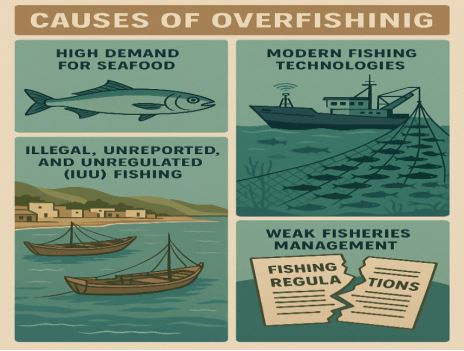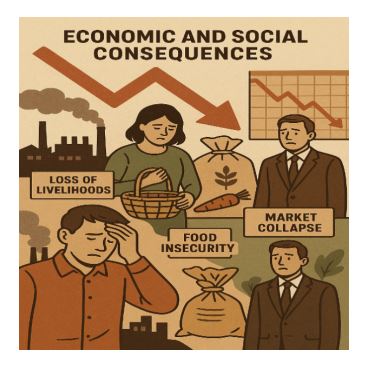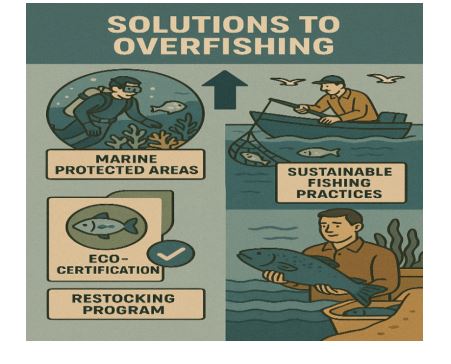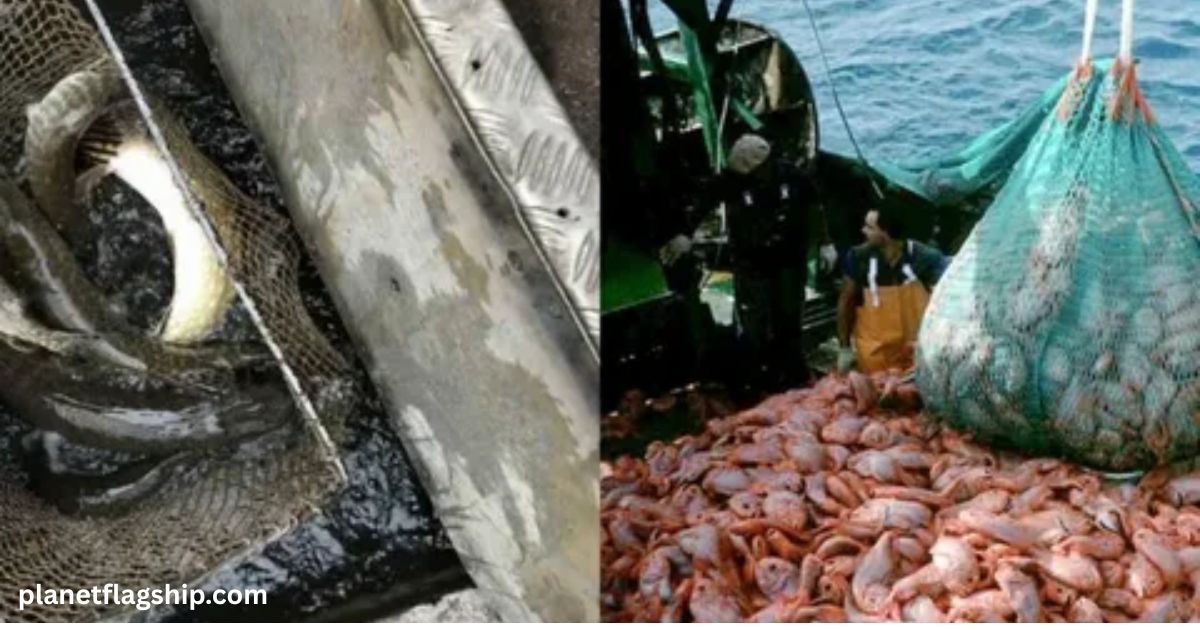Introduction
Deadly Impact of Overfishing occurs when fish or marine species are removed excessively from water bodies. This removal rate exceeds their ability to replenish themselves. This led to a decline in the population of marine species and even extinction. This is due to several factors, including a lack of regulations, excessive fisheries quotas, and inefficient fishing practices.
Modern fishing technologies and the growing global demand for seafood have led to the overexploitation of many fish populations. This unsustainable practice threatens individual species with extinction and disrupts marine ecosystems, food chains, and the livelihoods of communities that depend on fisheries.
Importance of the marine ecosystem

The marine ecosystem is critical to preserving our planet’s health properly. They give us many services, including:
Food security
For billions of people worldwide, the marine ecosystem is a primary source of food.
Climate regulation
With oceans absorbing approximately 25% of CO₂, the marine ecosystem plays a crucial role in regulating our planet’s temperature.
Biodiversity
From tiny plankton to massive blue whales, the marine ecosystem supports a vast array of marine life.
Thesis statement
Overfishing is a significant problem for marine species, which can lead to their extinction. The result of overfishing is far-reaching, and there is an urgent need to take action to address this issue and ensure the long-term sustainability of the marine ecosystem.
READ MORE: Are We Ready for the Next Climate-Induced Pandemic?
Causes of marine life extinction
1. Overcapacity and overfishing
The efficiency of global fishing industries has increased, with many vessels equipped with advanced technology and gear. The boats are relentlessly pursuing our fish. Lack of regulations and overcapacity have led to overfishing, which undermines the sustainability of fisheries.
2. Destructive fishing practices
- Bottom Trawling:
In this net, dragged along the sea floor, drags occur, which cause damage to habitats and catch non-target species.
- Dynamite fisheries:
In this, explosives are used to stun and kill fish, resulting in habitat destruction.
READ MORE: Are We Ready for the Next Climate-Induced Pandemic?
3. Global demand for seafood:
Recently, global demand for seafood has increased due to high population growth rates and shifting consumer preferences. Due to this pressure, the extraction of fish from the marine ecosystem has increased to meet people’s food requirements.
4. Illegal, Unreported, and Unregulated (IUU) Fishing
This refers to fishing that:
- Happens in prohibited areas
- Exceeds quotas
- It is not reported to the authorities
IUU fishing undermines conservation efforts and is a major contributor to fish stock depletion.
Many fisheries do not comply with legal quotas or regulations.
5. Subsidies to Fishing Industries
In many parts of the world, governments lack the resources or political will to enforce sustainable fishing regulations. As a result, quotas are ignored or poorly enforced.
Government subsidies often promote overfishing practices and support overcapacity.
6. Poor Fisheries Management

Lack of scientific data, weak enforcement, and political pressures result in mismanagement.
Marine Species at Risk
1. Atlantic Cod
Once abundant, it has now declined due to high rates of exploitation. Once a major food source, cod populations have declined in various areas, such as the Grand Banks of Canada, due to overfishing.
2. Bluefin Tuna
The area has been overexploited for sushi markets and is now at risk of becoming endangered.
3. Sharks
Many areas have seen a reduction of over 90% in shark populations, often due to the demand for their fins. Over 100 million sharks are killed each year, mostly for their fins. Many species have been critically endangered.
4. Sea Cucumbers
Highly valued in Asian markets, their over-harvesting is damaging reef ecosystems. Harvested for traditional medicines and food in Asia, this species is crucial for the health of the ocean floor but is vanishing due to a high rate of overexploitation.
5. Groupers and Snappers

Popular in restaurants, this species is slow-growing and prone to overfishing. Restaurants and markets heavily target these slow-growing, reef-dwelling fish, but their low reproductive rate makes their recovery difficult.
Effects of overfishing on marine species
1. Depletion of target species
Overfishing can lead to the depletion of target species, ultimately resulting in their extinction. There can be cascading effects throughout an ecosystem when the fish population declines.
2. Bycatch and discarding
Bycatch is defined as the unintentional catching of non-target species, which are then discarded back into the ocean. This includes fish that are not commercially valuable or protected by law. Trawling and longlining fishing methods capture non-target species, including dolphins, sea turtles, seabirds, and juvenile fish, many of which perish after being caught.
3. Habitat destruction
Numerous ineffective fishing practices can harm ecosystems and habitats, thereby reducing biodiversity and compromising their resilience.
For instance, bottom trawling and other fishing methods pose a threat to the coral reefs that many marine species rely on as vital habitats.
4. Collapse of Food Webs
The decline of predatory fish disturbs the balance of marine ecosystems. Removing predators (such as sharks or tuna) or prey (like sardines or anchovies) can cause an imbalance in the food web, leading to population crashes of other species.
5. Genetic Impact
The selective removal of larger individuals can alter the gene pool and impact the recovery of the population.
Economic and Social Consequences

1. Loss of Livelihoods
Millions of people in coastal communities rely on fishing for their livelihoods and food. Millions of people worldwide, particularly in developing countries, rely on fishing practices for their livelihoods. When fish stocks collapse, entire communities suffer.
- Food Insecurity
Overfishing poses a significant threat to the global seafood supply, particularly in developing nations.
3. Market Collapse
Unsustainable practices lead to fisheries closing, affecting national economies.
4. Conflict Over Resources
Scarcity can lead to territorial disputes and illegal fishing in foreign waters.
Global Hotspots of Overfishing
1. South China Sea
High competition and weak regulation.
2. Mediterranean Sea
Over 90% of assessed fish stocks have been overfished.
3. West Africa
Foreign fleets are exploiting local waters, affecting local fishers.
4. Pacific Islands
Tuna fishing by industrial fleets is affecting local ecosystems.
Case studies
- Bluefin tuna
According to the IUCN Red List, this species is listed as endangered due to overfishing and high demand for it.
Since the 1970s, the population of this species has declined at a very high rate. Some species are declining at a rate of 80%.
Conservative efforts are important, including the implementation of catch limits and regulating international trade.
- Sharks and rays
These species are targeted for meat and fins. They face the risk of extinction due to overfishing.
Every year, millions of sharks are killed for their fins.
Habitat protection and enforcing laws against shark finning are among the most effective efforts.
Solutions to overfishing

- Sustainable fishing practices:
Promoting sustainable practices can help reduce overfishing, ultimately contributing to the long-term sustainability of marine ecosystems.
For example:
- Catch limit:
Setting a catch limit for fish will help prevent overfishing.
- Marine protected areas:
Establishing protected areas would be beneficial for vulnerable species and habitats.
- Regulation and enforcement:
For the prevention of overfishing, ensuring compliance with regulations and laws, as well as effective enforcement, is crucial to strengthen. This includes measures such as penalties for non-compliance, as well as monitoring and surveillance.
- Community-Based Management:
Involving local communities in monitoring and enforcement.
- Eco-Certification:
Programs like the Marine Stewardship Council (MSC) promote responsible consumer choices.
- Restocking Programs:
Breeding and releasing endangered species to restore the populations.
- International Agreements:
Treaties like UNCLOS and CITES help regulate fishing at the global level.
- Reducing Subsidies:
Reforming harmful government subsidies that help to support overfishing.
Role of Consumers and Awareness
The power of individual action cannot be underestimated in the global fight against overfishing. Consumers play a crucial role in shaping market demand, which in turn influences fishing practices. By making informed choices and promoting awareness, consumers can help shift the fishing industry towards sustainability.
1. Responsible Consumption
One of the most effective ways consumers can contribute is by choosing sustainably sourced seafood. Opting for fish certified by organizations like the Marine Stewardship Council (MSC) or the Aquaculture Stewardship Council (ASC) ensures that the seafood was caught or farmed in ways that protect the environment and maintain healthy fish populations in the region. Consumers can also support local, small-scale fisheries that follow traditional, sustainable practices.
2. Reducing Waste
A significant portion of global fish catch has been lost or wasted due to poor handling, transportation, or consumer discard. Reducing food waste by buying only what is needed, storing seafood properly, and using leftovers can help minimize pressure on marine resources. Supporting improved post-harvest practices, such as better preservation and packaging techniques, can also minimize losses along the supply chain.
3. Advocacy and Education
Spreading awareness about the dangers of overfishing is important for generating broader public support for sustainable policies. Consumers are able to:
- Participate in awareness campaigns, marine conservation events, and sustainability practices.
- Educate others about the environmental and social impacts of overfishing on marine species.
- Advocate for stronger regulations by supporting NGOs and lobbying policymakers to promote marine conservation laws.
Through these combined efforts, consumers can drive positive changes from the marketplace to the policy level, helping to protect endangered marine species and restore ocean health.
FAQ’s
What is overfishing and why is it dangerous?
Overfishing happens when fish are caught faster than they can reproduce. This puts entire species at risk of extinction. It also damages marine ecosystems and threatens food security worldwide.
Which marine species are most threatened by overfishing?
Species like Bluefin tuna, Atlantic cod, sharks, sea cucumbers, and groupers are heavily overexploited. Many of them reproduce slowly, making recovery difficult. Without protection, these species could disappear forever.
How does overfishing affect the ocean ecosystem?
Removing too many fish disrupts the food chain and weakens biodiversity. Predators lose their prey, coral reefs suffer damage, and ecosystems collapse. In the long run, ocean health declines dramatically.
What are the economic and social impacts of overfishing?
Millions of coastal communities rely on fishing for income and food. When stocks collapse, jobs vanish and food insecurity grows. This can even lead to conflicts over dwindling resources.
How can overfishing be stopped?
The solution lies in stronger regulations, catch limits, and marine protected areas. Consumers can help by choosing sustainably certified seafood. Global cooperation is key to protecting oceans for future generations.
Conclusion
Overfishing is not just a threat to fish; it is a threat to oceans, economies, and the future food supply. If not addressed urgently, many marine species would become extinct, and ocean ecosystems may collapse. However, by combining conservation science, government policy, responsible fishing practices, and public awareness, we can mitigate the damage. The path to saving the oceans lies in sustainable action and global cooperation.
References
FAO (2022). The State of World Fisheries and Aquaculture.
WWF (2021). Overfishing and Marine Biodiversity.
IUCN Red List of Threatened Species. www.iucnredlist.org
National Geographic. Oceans and Overfishing.
Pauly, D. & Zeller, D. (2016). Global marine fisheries catch reconstructions.
UNEP Reports on Ocean Health.

John is a professional blogger and passionate advocate for environmental sustainability. With years of experience exploring eco-friendly practices and green innovations, he shares insightful articles on Planet Flagship to inspire a sustainable future. John’s expertise lies in making complex environmental topics accessible and actionable, empowering readers to make meaningful changes for the planet.
